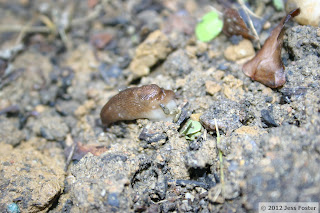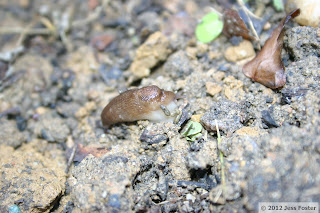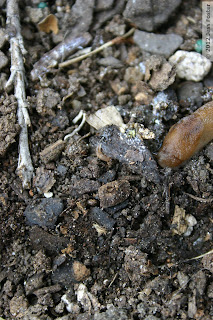In these first photos, notice the constant expanding and contracting of the pneumostome, the proximity of the anus to the pneumostome, and the form of the excrement (pellet-like capsules of digested, compacted organic matter, obviously the feces of an herbivore, revealing the slug's diet of plant matter; the chain of these pellets resembles a link of sausages).
 |
| The dark pellet has fallen and now another is being slowly extruded from the anus. |
 |
| The slug appears to notice the dangling pellet and its behavior suggests an an attempt to remove it. |
 |
| Failing to remove the pellet, the slug crawls away, perhaps also because of my presence, having uncovered its sleeping place. |
I've found that the rooms of Hotel Slug are usually filled with filth...
Even white mold grows in the hotel rooms...
Yay, fiber...
 |
| Look at the yellow-brown pool of liquid to the SW of the slug (Deroceras laeve)...could be urine. |
 |
| Not sure if that's urine or not next to the slug (Deroceras laeve). Could be loose feces. |
So, I hope I haven't grossed you out, but if you've read this far you've probably developed at least a tentative interest in the excretory processes of Lehmannia valentiana and Deroceras laeve. Regardless of slugs' lack of hygiene, it's fascinating to me to examine how their bodies function. Even such an overlooked process as defecation has its own beautiful efficiency about it. Just like the other functions of a slug's body (respiratory, pulmonary, reproductive, neural, etc.), excretion requires a system to operate properly. All the parts have to fit together and work together to keep the slug alive. Just think: without being able to rid itself of waste, a slug's or a human's body would deteriorate and die. This is merely another example of God's engineering.
But we don't even have to talk about excretion. Look at reproduction--the egg. If one aspect malfunctions, the baby slug inside will either die or be born with some deficiency/defect. Human infants in the womb are no different. God designed both the egg and the womb of His creatures to be nurturing, protective environments until the time is right for them to be born. Mindless evolution did not create these things; God in His wisdom did. He is the fashioner of all things; to Him be the glory. This isn't to say that all creatures are born perfect. By no means, but that is the result of Sin's presence in the world, and although the world is imperfect, God's will is, and Sin will remain until such time as He decrees. Thus, in spite of the deficiencies caused by Sin, we can still marvel at God's design, resting in the knowledge that Life has meaning and that we're not part of some random, capricious, torturous process originating in nothingness, but creatures God-loved and God-breathed. Just as a slug owes its existence and functioning to God, so do we. He is the one who gave us a heart, lungs, eyes, sexual organs, limbs, digestive and excretory systems, and of course, a brain. He designed each part to work in harmony with the rest, each cell to work in concert with the billions of other cells. And even though Sin often disrupts that harmony, it cannot destroy our soul, which God holds in the palm of His hand. Nor can Sin destroy the love God has for us humans and for His other creatures such as the slugs. Think about that.
































No comments:
Post a Comment